Don't wanna be here? Send us removal request.
Text
History of Magic| Thursday. July 12th, 2018| Lesson Eight: Founders of the School
The founders of Hogwarts School of Witchcraft and Wizardry wanted to represent each aspect they would like to see in new students. Each brought different character and personality traits to the table and allowed for students to fit into the four different houses based upon said traits.
Godric Gryffindor
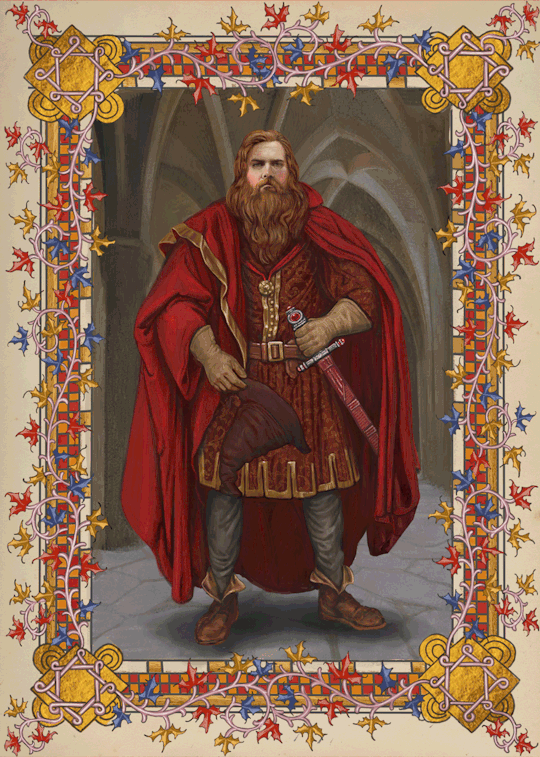
Godric Gryffindor is known to be one of the most powerful duellers of his time. Another interesting fact about him is that some called -- and still call -- him the “crusader against Muggle discrimination”.
Of all the founders, Godric Gryffindor was closest friends with Salazar Slytherin. However, as most of you might have already known, there was a large argument between these two friends when they noticed the difference in what they would like Hogwarts to become.
Like the other founders, Godric tried to shape the Gryffindor house to be like him: loyal, brave, and fearless. It was known that many times, he stood up for his friends, including Salazar Slytherin.
As Second Years, you will have already gone through your very own sorting ceremony, but did you know that the Sorting Hat once belonged to Godric Gryffindor?
While the founders were alive, they were able to sort the students of Hogwarts into different houses, but they got worried about what to do when they passed on. Relying on all four of them becoming ghosts was an unlikely option. Thus, Godric removed his hat and all four witches and wizards enchanted the hat together to give it the “brains” to sort even when they were no longer available.
Salazar Slytherin
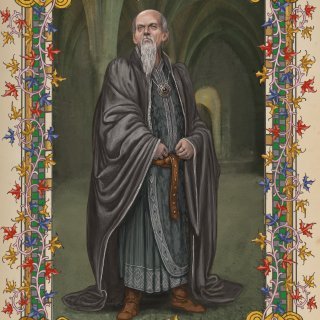
Salazar Slytherin had a great many achievements, beliefs, and discoveries attributed to him, including being an adept Legilimens. Unfortunately, however, the thing about him most people know him for is his belief that magic should always remain within a strict group of pure-blooded families; he insisted the Hogwarts must not allow anyone else into the school. This was also the beginning of the well-known argument between the founders. However, contrary to popular belief, Salazar Slytherin was actually a loyal friend, and not a bigoted villain. His scorning of Muggle-born students was actually born out of a desire to protect the rest of the students in the school, as he believed they may betray them to Muggles.
Salazar Slytherin had a special talent. He was a Parselmouth, meaning he could speak with serpents. It was due to his talent that he was almost killed as a child. He tried to defend a Muggle girl, who was bullied, by speaking to a snake and telling it to attack the aggressors. Frightened, the girl ran home and told her parents about what Salazar had done, causing him to be brutally beaten. Salazar’s parents were able to save him and get their revenge, killing the man, but his hatred of Muggles remained.
Salazar had no idea that Godric was in fact a Muggle-born. When he turned to the other founders for support, he was only met with rejection, as Ravenclaw and Hufflepuff did not see a reason to bar Muggle-borns from their institution.
Students of Slytherin are known to be ambitious and cunning. They would do anything to achieve what they believe in.
Following Salazar’s failed attempt to only accept pure-bloods in the school, he created the Chamber of Secrets and placed a basilisk inside it. This basilisk was placed in order to rid all Muggle-borns in Hogwarts, should the worst come to pass, and fulfill this “noble purpose” Salazar had set for it to do.
Helga Hufflepuff
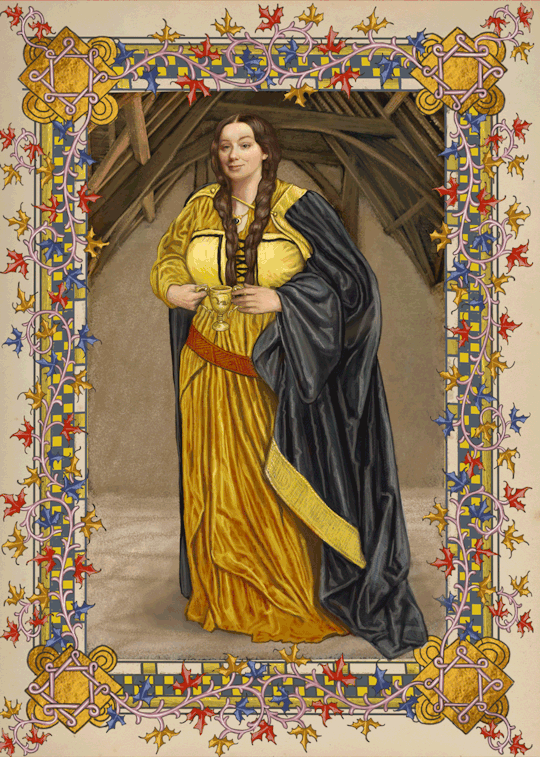
Helga Hufflepuff came from a very mundane and simple family in Wales. She was the oldest of three children, though the other two children were adopted (one magical and one Muggle). This has allowed her to nurture the motherly characteristics she became famous for and that she has brought to her house in Hogwarts. Caring for her students’ well-being was more important than anything else.
Interestingly, Helga was famous for her wide variety of food-related charms, many of which were, and still are, present in Hogwarts’ feasts. Through food, she was able to form connections with people of many different backgrounds. She had an avid interest in various cultures, Muggle and magical alike. Helga immersed herself in many a culture and was always open to learning about others. This also contributed to her charismatic nature.
Rowena Ravenclaw
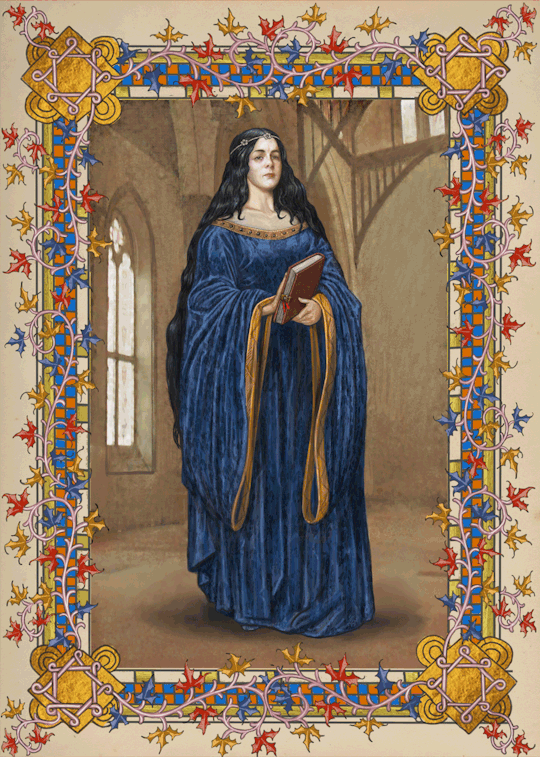
Born in Scotland, Rowena’s maiden name was actually not Ravenclaw. She took the name from her husband, Jares Ravenclaw. Jares was Helga’s cousin. Rowena knew Helga before knowing Jares, and through her friendship with Helga met Jares Ravenclaw, who was ten years her senior. He was persistent in winning her heart, despite her sole interest and love for knowledge rather than relationships. In the end, she was won over with not only his perseverance but also his wit.
As a child, Rowena was always a lover of knowledge and learning. This allowed her to advance her skills in various realms of magic and brought about her interest in magical architecture. It was a relatively rare topic at that time as resources were scarce, but Rowena was determined to use this ability in one form or another. The opportunity arose when Helga introduced her to Salazar and Godric, and thus the idea for Hogwarts was born. Then, she invested all her time into the magical architecture of Hogwarts, the magic behind which is still a mystery to witches and wizards to this very day.
Rowena Ravenclaw became a widow when a wizard’s misfired spell killed her husband. Thus, she brought her daughter, Helena Ravenclaw, with her to live in Hogwarts castle, where she dedicated all her time to teaching and learning. She buried herself in work to distance herself from the hurt in her heart caused by her husband’s death. However, this caused tension between her and her daughter as the latter felt neglected. As a result, Helena later fled the castle with the fabled diadem of wisdom her mother had enchanted. This brought about more hurt to Rowena -- more than she was willing to admit -- as she refused to let go of her pride and denied that her daughter had run away.
Even on her deathbed, Rowena never got to see her daughter one last time. She died of illness and a broken heart in 1000 A.D.
Rowena Ravenclaw had formed the Ravenclaw house with knowledge and wisdom above all else, and had a fair bit of trouble establishing relationships with people. Instead, she sought comfort in her collection of books that was later donated to the Hogwarts Library. The amount of books from Rowena make up a substantial part of the Hogwarts Library to this very day.
1 note
·
View note
Text
History of Magic| Friday. July 13th, 2018| Lesson Nine: Formation of Ministry of Magic
The Wizards’ Council
When talking about the history and the formation of the Ministry of Magic, we must go back much farther than 1990. Before the year 1000, as you have learnt in previous lessons, wizards lived in close harmony with Muggles everywhere in the world. Although the wizarding world didn’t believe they had to announce their existence, Muggles had the knowledge of and, for the most part, tolerated it. For Muggles, it was easy not to interfere in the wizarding world, due to their incapability and ignorance. On the other hand, wizards often found it more difficult to not interfere with the Muggle world due to their skills and knowledge.
Of course, treaties between wizards and Muggles appeared before those years, but old documentation records the first name of a governing group around 990 called the Wizards’ Council. This council, founded around that year, combined the efficiency of a governing group of intelligent leaders with the combined power of a king or emperor. It was, as we would look at it now, a predecessor of the current Ministry of Magic, although, the Wizards’ Council in function was more like the current Wizengamot. The first real record of this council being of service for the wizarding community lie deep within the Ministry’s archives and state this council’s involvement in the founding of Hogwarts, and the creation of the governmental rules and legislation thereof.
The council constantly changed its number of seated council members, from ten at the start, to more than 100 at its largest. These one hundred members weren’t all human wizards, as the council had a difficult time deciding who in the wizarding world should be qualified to share in the governing and legal rights of the council. In 1450, Burdock Muldoon, the Chief Warlock of the Wizards’ Council at that time, declared that “any two-legged creature, hereafter named ‘a being’, may send not more than eight representatives to the upcoming Wizards’ Council meeting, at exactly five strikes of the clock on the Wednesday, May Eighth. While all other creatures, hereafter named ‘beasts’ are banned from said council meeting”. Thus all bipedal creatures were present that day, including a large number of undesirable creatures as Fwoopers, Pixies, Vampires, Trolls, and Yetis. One should note that he excluded the merpeople and centaurs, now impossible to imagine, and that, understandably, the meeting that day went terribly wrong, as you can read in in the records found within the Ministry.
Organizational Shift: Council to Ministry
After the disastrous meeting in 1450, nothing was seen from Chief Muldoon and the new Chieftainess Elfrida Clagg took over, and immediately changed the definition of beings “as being able to speak the human tongue, and could make themselves understandable by council members”. Although that created a better work environment, the Centaurs still weren’t satisfied with the definition, mainly because it excluded the merpeople. Clagg, however, never changed the definition, as a perfectly capable situation was created. She also changed the legislation of the Quidditch games, which, until then, used a Golden Snidget to chase after and win a game. Clagg declared the Snidget to be an endangered species, and proposed a substitute, the Golden Snitch, a golden ball with silvery wings, exactly the same size as the original creature, made by Bowman Wright.
Warlocks’ Conventions
Concurrent with the founding of the British Wizards’ Council, a second, more international governing body was created. The International Warlock’s Convention, founded between the years 1100 and 1150, bound all members to an international governmental body. Little is known about the convention, as its archives are confidential, open only to the members of the current incarnation of the International Warlock’s Convention. Only its legislation and rulings are published. We do however know about a couple of these conventions:
The Warlocks’ Convention in 1289, in which they probably discussed the problems of Quidditch, as it became a nuisance to keep it a secret from the Muggle world, or the future possibilities of international educational cooperation.
The Warlocks’ Convention in 1627, decreeing all magical nations should create a national governing body to protect its citizens from harm and enforce the magical law created.
The Warlocks’ Convention in 1675, to change their official name into the International Confederation of Wizards, and start working on the International Statute of Secrecy, which was finalised in 1689.
A later convention in 1709, where they passed legislation that outlawed dragon breeding for good.
Following the convention of 1627, the British wizarding community, already guided by the Wizards’ Council, expanded its governmental body and created the Ministry of Magic in 1629, together with several departments for efficiency, and moved the body to a central location (Whitehall, London). One such department of the Wizards’ Council was stripped of all legislative and executive powers, therefore becoming purely a judicial body, and was renamed the Wizengamot, with the Chief Warlock position serving as the group’s head.
0 notes
Text
Mythology| Friday. July 13th, 2018| Lesson Eighteen: Maya Myths
Much like the various nomes of Egypt, the Maya empire was made up of many smaller cohesive groups. This meant, among other things, that defining one specific culture or pantheon for the Maya is tricky at best. Additionally, as noted with the Aztecs, the Maya pantheon overlaps considerably, with two gods occasionally combined as one, one god having multiple forms, or having multiple names for one god depending on the time or place, and sometimes just having different names for the same god based on regional cultural differences. This only adds to the difficulty in picking apart separate deities for modern-day researchers. Finally, you will likely notice some similarities between the Maya pantheon and the Aztecs based on the fact that the Maya’s pantheon came before and their beliefs exerted some influence on later societies.
Maya Pantheon
One thing you will notice as rather unique to the Maya pantheon is that often one god can have exactly four separate incarnations. In these cases, sometimes the gods will be referred to by a single name, sometimes each of the four incarnations will have four separate names, but be related to each other and considered to be part of the same god. That is, a god can be referred to with one name and be identified by that name, but can also have separate names for their four incarnations. You will see what I meant shortly. This phenomena is due to the beliefs of the Maya and the fact that they felt the world had four corners, thus creating a new facet of a god for each one.
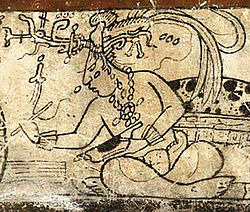
Ah Mun The god of corn, or maize, Ah Mun was highly respected as he represented the most important Maya crop. Naturally, he is also associated with agriculture. He is always depicted as a young man, with ears of corn making up a headdress.
Ah Puch This god goes by many other names including Cizin and Yum Cimil, and can even be split into two separate deities known as Hun Came and Vucub Came. No matter his name, he is always a highly feared and malicious god. Ah Puch was the primary god of the underworld in Maya tradition, called Xibalba. More specifically, his dominion was the ninth, and lowest level of the Xibalba. I could indeed go on for some length about the Maya underworld, its thirteen primary gods, and their domains (whether it was presiding over a level of the underworld or bringing disease to the humans above), but suffice it to say it was not an enjoyable place. The realm was treacherous to approach, with many obstacles in the path of unwary explorers. More, once an explorer arrived in Xibalba, much of it was full of traps and tests to snare them.
Bacab, or the Bacabs The son of the head deity, Itzamn (who will be covered shortly), Bacab is associated with many magic rituals, including divination, particularly when related to predicting the fertility of crops. He also had an association with the sky like Itzamn. Each of them was placed along the four corners of the world in order to hold up the sky, as there were fortunately four incarnations. The Bacab of the north was named Cantzicnal, the south Hosanek, the east Hobnil, and the west Saccimi. The Bacabs are also highly intertwined with the four wind deities, Pauahtun, insomuch as in some traditions they are one and the same.
Chac, or the Chacs Like the Bacabs, the Chacs (also called the Chaacs or the Chaahks) were another four-in-one deity. The Chacs functioned as rain gods, each one associated with a cardinal direction. Because of their association with rain, they were heavily involved in any rituals or prayers surrounding agriculture or rain. They were all associated with the same aspects and were prayed to equally.
Ek Chuah Also called Ek Chuaj or Ekchuah, this formidable god was a violent one. He was the god of war and the god of death in battle or human sacrifice. This made him quite prominent in Maya society. Interestingly, he had other functions and associations, such as being the god of merchants and one of the gods of travelers.
Hunahpu and Ixbalanque These two figures, also known as the Hero Twins, feature prominently in many Maya myths. They fall in the grey area between human and god, for reasons you will see next week. They are not to be confused with their father, Hun Hunahpu (and his twin, Vucub Hunahpu), who had some similar exploits, but is not as celebrated. Many rulers of the Maya empire claimed to be able to trace their ancestry back to these hero twins as a way to prove their worth and their right to rule.
Itzamn Also known simply as Zamn or Itzamna, this god was the lord of the heavens and was in control of both the day and night. Itzamn occupied the top, most powerful spot of the Maya pantheon, and was their creator god. Interestingly, he was viewed as quite benevolent and was called upon for help and mercy, something which is not often associated with Maya culture. He was often regarded as the spouse of Ixchebelyax and the father of the aforementioned Bacab.
Kukulkan This god is widely regarded as the Maya counterpart to the Aztec Quetzalcoatl, as his name means “feathered serpent.” Confusingly, at one time, there was also a very powerful wizard named Kukulkan and it is hard to tell which came first: the man, or the mythological god. It is equally possible that a powerful wizard either named himself after a god for reasons of prestige, or that the man was so powerful and famous, that he become immortalized in legend and more myths were fabricated over time. Regardless of which is accurate, Kukulkan is famous for creating humankind after a few attempts, alongside the god Tepeu.
Tepeu This god’s main claim to fame is the creation of humankind, alongside his partner Kukulkan. His initial failures (which will be mentioned next week) do not diminish his importance to the Maya people and he is viewed as a creator god.
1 note
·
View note
Text
Astronomy| Friday. July 13th, 2018| Lesson Eight: Lunar Legends
Lunatics and Lunacy
Many Muggles love observing the Moon. However, if you call a Muggle a lunatic, prepare for him or her to get mad. Although the Moon is a powerful and gentle force, there was a time when many Muggles believed that the Moon caused people to be extremely irrational. Many Western philosophers and laws use the word “lunatic” to discuss those who are unable to think rationally at a particular moment. While the majority of Muggles do not actually believe that the Moon causes irrationality, this meaning behind the word “lunatic” still remains today.
Moon and Muggle Tales of Magic
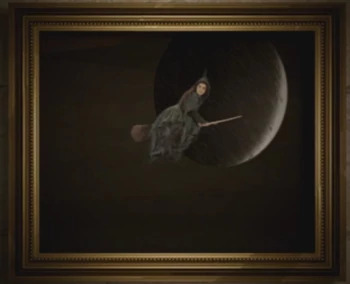
Remember this portrait from the castle? It shows a robed witch flying across the Moon. For many Muggles, this is a stereotypical depiction of witches - black robe, pointy hat, and broomstick. As a Muggle-born, I grew up listening to fairy tales of witches - most of them evil - cackling while casting supposed spells. Ever since the Statute of Secrecy, it seems like the most popular representations of witches in the Muggle world are stereotypes.
By why the Moon? How does the Full Moon tie into the image of a witch? In Chinese, Indian, and Western astrology, of which the basics are known to Muggles, the Moon represents feminine qualities, and thus it is connected to emotions and motherhood. It is interesting to note as well that many Muggle calendars from different civilizations are based on the Moon because the Moon’s phases are regular and easy to observe.
Perhaps the Muggle image of a witch on a broom in front of the Full Moon is a story about certain Muggles’ uncomfortable attitudes around femininity. Even though the stereotypical Muggle depiction of a witch is negative - she is often shown as evil and ugly - she is also shown as powerful and intelligent. Combine it with the idea that the Moon inspires irrationality as well as standing for feminine qualities, the stereotypical Muggle image of a witch could be seen as an attack on feminine power and strength.
Eclipses in History
During earlier times in human history, many civilizations noticed eclipses but did not have the knowledge to explain why they happened. As such, many civilizations created tales to explain why eclipses happened. In some societies, eclipses are seen as the doing of angry or hungry gods. For example, the Incas saw lunar eclipses as a very bad sign. According to Incan stories, a lunar eclipse occurs when the angry jaguar god munches on the Moon. After he is done, legend suggests that he may come to Earth and munch on its inhabitants as well.
While these stories may seem entertaining and frivolous today, it is important to note that much early astronomical work was done to predict eclipses. Many early advanced societies developed their astronomical knowledge by attempting to predict eclipses. In addition, these eclipses help historians to pinpoint historical events. Since eclipses happen at particular times, they can be used to date events in the past, especially since the people of the past would have noticed the eclipse because eclipses are very noticeable.
3 notes
·
View notes
Text
Defence Against the Dark Arts| Thursday. July 12th, 2018| Lesson Thirteen: Banishing Spell, Melofors Jinx, Cushioning Charm
The Banishing Charm
The Banishing Charm (Depulso) is the counter-charm to the Summoning Charm. As Accio summons objects to the caster, Depulso sends both objects and living things away from the caster. Unlike the Summoning Charm, which can summon specific objects from anywhere, the Banishing Charm banishes whatever the wand is aimed at.
Depulso can be used to shoot objects away from the caster, whether a living organism or an object. It can be used in duelling, as proved by Severus Snape (in alternate reality) when he blasted Dolores Umbridge away from himself.
Melofors Jinx
The Melofors Jinx (Melofors) is a jinx that encases the victim's head in a pumpkin, although it appears to those watching to transform the victim's head into a pumpkin. The pumpkin can be shattered to free the victim, or can fall apart on its own after a short time.
Harry Potter, Ronald Weasley and Hermione Granger used this spell on various erklings throughout the grounds of Hogwarts Castle during the 1994-1995 school year, overlooked by their Defence Against the Dark Arts teacher, Professor Bartemius Crouch Jr (who at the time was disguised as Alastor Moody).
In the very next school year, Headmaster Albus Dumbledore managed to escape Cornelius Fudge, Dolores Umbridge and Percy Weasley after they came to arrest him, and the next day a rumour spread that Fudge was in St Mungo's Hospital for Magical Maladies and Injuries after having had this jinx used on him.
The Cushioning Charm
The Cushioning Charm (Molliare) creates an unseen softening effect on target surfaces. It is primarily used in broomstick manufacturing to make the brooms more comfortable for riders.
This charm was invented by Elliot Smethwyck in 1820.
During their break-in of Gringotts Wizarding Bank, Hermione Granger used this charm to protect Harry Potter, Ronald Weasley, Griphook, herself, and an Imperiused Bogrod when the Mine Cart in which they were riding derailed after passing through the Thief's Downfall.
Scorpius Malfoy and Albus Potter used this spell when escaping the Hogwarts Express.
2 notes
·
View notes
Text
Charms| Thursday. July 12th, 2018| Lesson Six: Memory Charm, Tickling Charm, General counter-spell
A Memory Charm (Obliviate), also known as a Forgetfulness Charm, was a spell that could be used to erase memories from an individual's mind. It was different from the charm that creates false memories
Incantation: Obliviate (oh-BLI-vee-ate)
Type: Charm
Hand movement:

Light: Green
Effect: Erases memory
Creator: Mnemone Radford (1562-1649)
Mnemone Radford was the witch who first developed Memory Modifying Charms. She became the first Ministry of Magic Obliviator, due to her skill with the charm.
These spells are used routinely by the Ministry of Magic as they work to keep the wizarding world a secret from the Muggles.
Minister for Magic Ottaline Gambol was responsible for the creation of the Hogwarts Express to transport young witches and wizards to Hogwarts. However, the secrecy surrounding the project entailed a mass operation involving one hundred and sixty-seven Memory Charms and the largest ever mass Concealment Charm performed in Britain.
Some Muggles slipped through the cracks in these situations, according to Blenheim Stalk in Muggles Who Notice. When particularly intense memories needed to be erased, it often left the victim disoriented for a short period of time, as happened with the Roberts family after the Quidditch World Cup in 1994.
If performed improperly, a Memory Charm could erase significant portions of an individual's memory and cause brain damage, with difficulty in recovery. For instance, Gilderoy Lockhart attempted to wipe the memories of Harry Potter and Ron Weasley during the events surrounding the re-opening of the Chamber of Secrets.
However, Ron's damaged wand backfired, thus causing Lockhart to suffer extreme obliviation. He thereafter became a permanent resident in the Janus Thickey Ward of St Mungo's. Although Lockhart did retain some of his memories (mainly his vain liking for signing autographs despite not knowing why, and knowing how to write in cursive), he never fully recovered.
Barty Crouch Snr placed a Memory Charm on Bertha Jorkins to try to make her forget her discovery that he was keeping his son in captivity. However, the charm he put on her was was too strong, and thus it damaged her memory permanently, making her chronically forgetful about other things as well.
Breaking the charm:
Memory Charms could be broken through torture. In 1994, Lord Voldemort and Peter Pettigrew broke a Memory Charm placed by Barty Crouch Snr on Bertha Jorkins, and extracted information from her regarding the whereabouts of Crouch's son. However, the breaking of the charm had caused a great toll on Bertha, and her body and mind was damaged beyond repair.
In 1997, Voldemort had Antonin Dolohov and Thorfinn Rowle tortured with the Cruciatus Curse after they failed to capture Harry Potter. Hermione Granger had cast Memory Charms on them so as to cover the trio's tracks. It appears that the charms were not broken by torture, since the Death Eaters remained unaware that Ron Weasley was with Harry and Hermione, rather than sick at home with spattergroit, as had been claimed. This may mean that a certain level of torture was necessary to break the charm, or that the torturer needed to be specific on wanting to break it, rather than just inflicting the pain.
Since Lockhart's backfired Memory Charm was never been broken through, it is possible that torture was the only method of complete recovery (with possibly irreparable mental and physical damage being clear side-effects), as it is doubtful that St Mungo's Hospital for Magical Maladies and Injuries would commit crimes against humanity just to recover Lockhart's memory. It is also possible, however, that since it was cast improperly, Lockhart's memory was actually erased permanently with no chance of recovery whatsoever. Although spending time in the hospital did help him regain the basics of his memory — mainly to write in cursive and his enjoyment of signing autographs, the latter of which he does not remember why — he never fully recovered.
Etymology
The incantation "obliviate" may be derived from the Latin oblivisci, meaning "to forget", or the English word oblivion, defined as "the fact or condition of forgetting or having forgotten".
It may be derived from the Latin term oblivio, which also means "to forget"
The Tickling Charm (Rictusempra), also known as the Rictusempra Charm, is a spell that causes a victim to buckle with laughter. It also has at least two other side effects on the victim.
Incantation: Rictusempra (ric-tuh-SEM-pra)
Type: Charm
Hand movement:

Light: Silver
Effect: Tickles and weakens
It is usually used as a diversionary tactic in duels. Harry Potter used it on Draco Malfoy in the Duelling Club during their second year. It is not known if this affects a person who is not ticklish, however in the Chamber of Secrets film, Malfoy was knocked backwards instead, and perhaps this could be the effect on a person not ticklish.
General Counter-Spell
The General Counter-Spell (Finite or Finite Incantatem) is a counter-spell for general use. It may be used in duels or on an entire home, as a precaution before a wizard answers the door. It is taught at Hogwarts School of Witchcraft and Wizardry.
Incantation: Finite (fi-NEE-tay)
Finite Incantatem (fi-NEE-tay in-can-TAH-tem)
Type: Counter-spell
Hand movement:

Light: Red
Effect: Terminates all spell effects
The General Counter-Spell terminates all spell effects ranging from simple spells like the Jelly-Legs Jinx to more complicated spells such as Atmospheric Charms.
2 notes
·
View notes
Text
Transfiguration| Wednesday. July 11th, 2018| Lesson Five: Rabbits and Slippers
Organic and Inorganic Materials
Organic materials are those that come from some living organism, either a plant or an animal. Examples of some organic compounds include nucleic acids, sugars, fats, proteins, enzymes, and hydrocarbon fuels, or compounds that consist of only carbon-hydrogen bonds. While inorganic compounds include salts, metals, and other substances composed of single elements or lacking a carbon-hydrogen bond. In terms of transfiguration, organic materials are typically harder to work with due to their increased complexity. They are composed of molecules and cells that are the building blocks of life and therefore have a stronger resistance to unnatural change.
Rabbits
Rabbits are small mammals of the family Leporidae. They can be anywhere from eight to twenty inches in length and have long ears that can grow to be four inches or longer. Their hind legs are strong, allowing them to jump and hop around the meadows, woods, deserts, wetlands, or grasslands in which they are known to reside. In terms of appearance, rabbits, also colloquially called “bunnies,” have long, soft fur covering their bodies and a large tuft in the rear that is their tail. They are herbivores, eating mainly grass and hay, but also enjoying fresh fruits and vegetables. They can also be domesticated, being a popular pet among wizarding families as they have a slight affinity for magic. They aren’t full magical creatures, so you do not need to worry about overcoming a strong magical barrier. However, they can sense magic, similar to owls, and certain parts, such as the fur, liver, and feet, can be used in potion making.
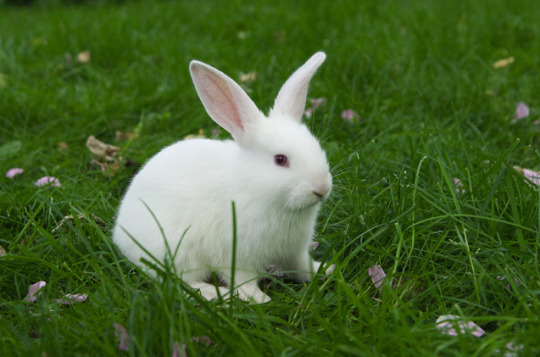
Slippers
Slippers are light footwear, typically worn indoors, that are easily put on and taken off. While there are many different types of slippers, from moccasins to Cinderella’s famous glass slippers, made from many different materials, today we are aiming for fuzzy slippers with synthetic fur. Fake furs can be made from acrylic polymers that are composed of chemicals derived from coal, air, water, petroleum, and limestone which are all inorganic compounds.

The Transformation
This spell we will be using transfigures one rabbit into one slipper. That being sad, you will need two rabbits in order for this spell to achieve its purpose. The spell information is given on the board, so when you feel ready, come up and grab a rabbit. Once you are successful with the first, you may attempt with a second if you so choose. Now onto the transformation!
You must be sure to concentrate on the intended materials for this transformation. Due to the strong visual and textural similarities that exist between rabbits and slippers, some forget that there are still more changes that must take place, particularly when it comes to the interior of the shoe and the molecular differences between natural and synthetic fur. It is for this reason that the issues that are most often seen with the Rabbits to Slippers Transformation include the creation of a solid slipper, such that there is no hole for your foot, and a slipper with real rabbit hair, rather than a synthetic fur.
Origin
Interestingly enough, the origin of this spell is completely unknown. Its first officially documented use was in 1792, but hints of its existence creep up in much older documents as well. Despite the efforts of many historians and transfigurists who, like myself, feel that knowing where a spell comes from increases the understanding of the spell itself, many believe that the creation story for this transformation is completely lost to the ages. Regardless, for as long as this spell has been known, it has had the sole purpose of keeping one’s feet toasty warm in the winter.
1 note
·
View note
Text
Herbology| Wednesday. July 11th, 2018| Lesson Nine: Fluxweed, Leaping Toadstool and Mandrake
Fluxweed
Fluxweed is a member of the mustard family known for its healing properties. The word “flux” means constant change or flow which only makes sense for this plant being an ingredient in the Polyjuice Potion. If to be used in making Polyjuice Potion, it should strictly be picked on a full moon.

Leaping Toadstool
A Leaping Toadstool, originally native to Great Britain, is a magical mushroom which has the ability to jump. It can grow from 3 to 4 inches in height and are often noticed for the robust and rounded stem, which is necessary for them to keep their balance while leaping. Leaping Toadstools cost three Galleons at the Apothecary in Diagon Alley, and can be found in the Forbidden Forest.
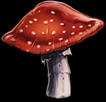
Mandrake
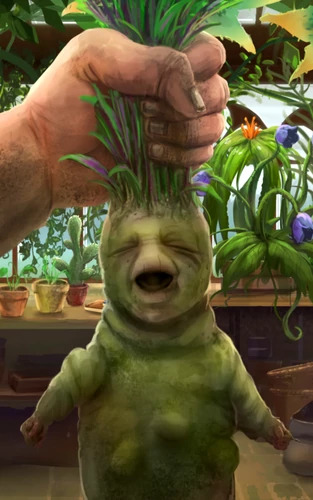
A Mandrake, also known as Mandragora, is a plant which has a root that looks like a human (like a baby when the plant is young, but maturing as the plant grows). When matured, its cry can be fatal to any person who hears it; a young Mandrake's screams will usually only knock a person out for several hours.
Mandrake plant has been used since ancient times as a medicinal plant and has a tradition associated with magical activities. It is a member of the nightshade family. It contains hyoscyamine, scopolamine, and mandragorin. Medically, it has been used as a pain killer and a sedative. It was used in ancient times for surgery. An overdose, though, can be fatal.
There are variations on the plant, Mandragora Offininarum being the most usual form, with the smaller Mandragora Autumnalis having the same properties. Some folk traditions call the latter (M. Autumnalis) variety as "Womandrake" in distinction to M. Officinarum as "Mandrake." A third variant, Mandragora Turcomanica, is a nearly extinct and very rare variety, found mostly in Turkey and a few areas of Iran. M. Turcomanica is distinguished from M. Autumnalis by having a larger fruit.
These plants are also known in the fields of medicine and potion making. Having knowledge about these plants could come in handy.
2 notes
·
View notes
Text
Mythology| Wednesday. July 11th, 2018| Lesson Seventeen: Mi'kmaq Mythology
The Mi’kmaq Creation Story
The story of creation begins with Gisoolg, the creator. Gisoolg is neither male nor female, Gisoolg simply is. It is not known where Gisoolg came from, only that this entity made everything.
The second entity in existence, and the first that was made by Gisoolg, was Nisgam, or the sun. The third entity, Ootsitgamoo, the earth that the Mi’kmaq can walk on followed shortly after. Ootsitgamoo was placed in the middle of Nisgam’s path, so the sun would watch over it.
The fourth entity, both the most significant creation in terms of humanity, and the one on whom we will focus much of our lesson today, is Glooscap (or Glooskap, among other spellings). Glooscap was created by a bolt of lightning smashing into Ootsitgamoo, which formed the ground into a humanoid shape. A second bolt of lightning gave him life, and a third allowed him to walk freely about the earth. Now, Glooscap may have looked like a human, but in the myth, he is said to have been incredibly tall - even taller than a giant.
The fifth entity in the story was born from a rock covered in dew. Together they were heated into existenceby Nisgam, taking the form of an old woman. Her name was Nogami and, although created after Glooscap, she was his grandmother. Nogami was born with great knowledge and was created to teach Glooscap respect for his elders, respect for living creatures, and the secret of fire. From this point on, Glooscap referred to the creatures of the sea and forest as his brothers and sisters.
The sixth entity, Netaoansom, appeared by Glooscap’s fire one evening, announcing himself as Glooscap’s sister’s son, effectively his nephew. The myth never explains who Glooscap’s sister is, nor does she make an appearance, however it is the nephew that is of significance in this story. To Netaoansom came the responsibility of teaching Glooscap about strength, hunting, and how the world around him worked from the view of a hunter.
The seventh and final entity in the creation myth was Neganogonimgosseesgo, Glooscap’s mother. Yes, it’s a bit of a mouthful, but she did play a crucial role. You will just have to buck up and commit it to memory! She began life as a leaf that had fallen to the ground and was covered with morning dew. Nisgam rose in the sky, shining light on the leaf, and at midday, Neganogonimgosseesgo was given life and human appearance. With her arrival, Glooscap’s family was complete.
The role of Neganogonimgosseesgo in Glooscap’s life was no less complex than that of a human mother to her child. She was said to have brought colour to the world, and was tasked with teaching Glooscap the strength to survive in the world around him, as well as an understanding of the world and the concept that its creatures have the same rights to live upon this earth as Glooscap, and their role as his companions and friends. Perhaps the most critical role she played was to teach Glooscap that mutual respect, understanding, and cooperation are the keys to living peacefully and harmoniously.
His education complete, Glooscap then proceeded to create mankind - specifically the Mi’kmaq people - from the sand of the earth. He lived with his family (which included the animals as well as the humans that he had created) on Mi’kmaq lands for many years, until he felt the people were ready to guide themselves. At this time, he and Nogami traveled far from the Mi’kmaq lands, leaving his mother and nephew to guide the Mi’kmaq people. His instructions upon leaving, however, were quite detailed and full of references to the number of entities involved in the creation story (seven):
Seven winters after Glooscap’s departure, seven sparks would fly from the Great Fire (which was created by Glooscap and never allowed to go out). From these sparks, seven people would be born, then seven more, then seven women, and seven men. They would form seven families, which would disperse to seven different areas surrounding the Great Fire. Once in their new areas, each group would further subdivide into seven groups, meaning 49 tribes in total. Each tribe would be a sufficient distance from the others so they could easily share in the natural resources of the earth.
After seven more winters, each of these groups would return to the Great Fire for a time of celebration of Gisoolg and all that was created. The celebration would signify all of the lessons that Glooscap had been taught by his family, and would be a time to honour their civilization’s place in the world.
This gathering had great traditions that needed to be followed to honour the creation of their world. Seven, fourteen, and twenty-one rocks would have to be heated over the Great Fire, then placed inside a wigwam, which was made with the saplings of seven alders, seven wild willows, and seven beeches.
Once completed, seven men from the seven original families would enter the lodge - after fasting for seven days - to give thanks and honour the seven directions, seven stages of creation, and to continue to live in good health. The steam from the rocks would clean their spirits.
A great many other pieces to the celebration were handed out, but lastly, and perhaps most interestingly from our perspective, was the recipe that Glooscap gave to his mother to create “ektjimpisun,” a remedy that could cure almost every kind of illness. It was made from seven plants that had to be collected in the correct order, at the correct time of day. These plants include alum willow, wild black-cherry, ground hemlock, and red spruce. Some of these plants you may already be familiar with - if you’ve taken herbology - as they do indeed have magical properties.
With the imparting of knowledge and practices completed, Glooscap and his grandmother left the Mi’kmaq lands, but swore to always watch over their people.
What differentiates this creation story from others we have studied throughout Europe and the Middle East is, first, its length and detail. I have heard the argument from young colleagues that the Sumerian myths must be more detailed and that the myth is only so well recorded because the Mi’kmaq civilization is so young. What they fail to remember is that the Mi’kmaq civilization dates back 10,000 years ago, which pre-dates the Sumerian empire. What the evidence leaves me to believe in this case is that the Sumerians wrote down their myths, thus they were destroyed by man or time after their civilization ended. The Mi’kmaq, on the other hand, have always used an oral tradition for teaching and telling myths and legends - there was never anything written down to be lost. As a species, the stories we are told when we are children stay with us, and we tell them to our children. As such, the Mi’kmaq stories were never lost throughout the generations.
Another differences between the Mi’kmaq creation myth and others around the world is the nonlinear nature of the creation of Glooscap’s family. He was created before his grandmother and mother were. In fact, his family was created for a very specific purpose - not to lord over a certain realm or element like the Greco-Roman gods, but to teach Glooscap very specific values, ethics, and knowledge that he in turn imparted to the Mi’kmaq people.
One other point to make before we look at a couple of other Mi’kmaq myths is the prevalence of the number seven in the creation myth. There are seven stages of creation, seven winters between gatherings at the Great Fire, seven tribes, seven ingredients in the potion that cures almost every illness, and many other references as well. No doubt the references to that specific number are due to the original seven stages of creation, however it is interesting to note that, in general, witches and wizards of Mi’kmaq descent are exceptionally skilled in arithmancy. Their innate knowledge of the significance of numbers aids them quite well in their studies at Ilvermorny.
Muin, the Child of the Bear
While Glooscap is the central figure in many Mi’kmaq myths, there are several in which he is a minor character, such as the story of Muin. This story is particularly interesting as it seems to have some reference to magic use.
The myth begins with a boy named Sigo whose father had died. His mother remarried to provide for her son, however her new husband was spiteful and disliked the child. One day, he took Sigo into the forest and had him crawl into a cave to practice his hunting skills. Once the boy had entered the cave, the stepfather rolled a giant stone across the opening and left the boy behind to die of starvation. He ran to a cliff near the ocean to celebrate his victory.
As you may recall, Glooscap swore he would watch over his people long after he left them. Upon seeing this act of treachery by the stepfather, Glooscap threw a great thunderbolt at the ground near where the stepfather was standing. So great was its impact on the earth that area shattered to pieces all the way up to the ocean, burying the stepfather in the rubble. The area was called Blomidon Cape, which still exists in the Canadian province of Nova Scotia today.
Determined to save the boy, Glooscap called on his faithful friend Matues, which means porcupine in English (and that is what Matues was). Matues was sleeping in the cave, and Glooscap asked him to calm poor Sigo and help him get out of the cave, for Matues was also inside. Matues and Sigo tried to move the boulder, but were not strong enough to move it.
Matues called out to the forest for all of the forest creatures to help. A great many came and pushed and pulled, but for all their combined strength, they could not move the boulder. When hope was all but lost, Muin’iskw, the mother bear, emerged from the forest, drawn by all of the commotion. When she learned what had happened, she immediately went to the boulder and pushed it out of the way.
The animals were then left with the predicament of what to do with the small child. Fearing that he was not safe with his people, the animals brought their favourite foods to the boy to see who would be able to feed him. Leaves, raw fish, and bugs were all refused by the boy, despite his hunger. It was only when Muin’iskw brought him blueberries that his hunger was satiated. At this, it was decided that Sigo would be raised by Muin’iskw along with her cubs.
And so it came to pass that Sigo was raised by the bear. In time, he forgot his old life and lived quite happily in the forest, all the time being kept away from other humans by Muin’iskw.
Of course, nothing can remain hidden forever, and one day hunters discovered the cave where Sigo and his family were sleeping. The hunters lit a fire to smoke out the bears in order to catch them more easily. Sensing the danger, Muin’iskw sacrificed herself by distracting the hunters while Sigo and her cubs escaped.
During the chaos, two of the cubs escaped, but the littlest cub was scared and moved too slowly. Seeing that the hunters had already killed Muin’iskw, Sigo threw himself upon his little sister and begged the hunters not to kill her. Astonished at the appearance of the boy, the hunters ceased and brought both Sigo and the cubs safely back to their people.
Reunited with his mother, Sigo and the cubs were in turn taken care of by the Mi’kmaq people. Sigo grew to be a great hunter in the tribe, however he refused to hunt bears in honour of Muin’iskw to whom he owed his life.
This myth certainly shows the connectivity of the Mi’kmaq to the animals, however there are versions of this myth that are quite fascinating from a magical perspective. According to some variations of events, the hunters who killed Muin’iskw swore to their leaders that there were four bear cubs that came out of the cave - not three cubs and a boy. They said that Sigo had transformed from a bear into a boy in front of their eyes.
Now, we know that it takes years to learn the type of transfiguration required to perform this feat, not to mention the aptitude and determination it takes to become an Animagus. Before we dismiss these possibilities, however, it is interesting to note that the aboriginal peoples of North America have the highest per capita ratio of animagi. Their myths - just as in the story of Sigo - are filled with references to people turning into animals, and vice versa. It was a well known, accepted talent that many of their people possessed. Whether a boy of about 10 years could perform such a feat, well, I will let you and the scholars discuss that to your heart’s content.
Jipijka'm - The Great Horned Serpent
Our final myth for today is quite brief - almost as short as the Inuit mosquito myth from our previous lesson. It is simply a description of a magical creature said to live in the coastal waters surrounding the Mi’kmaq homelands. Jipijka’m is described as a worm-like creature, approximately one inch long. It can, however make itself into a terrifying creature larger than a deer. These changes happen quite rapidly, as if by magic.
1 note
·
View note
Text
History of Magic| Tuesday. July 10th, 2018| Lesson Seven: The First Wizarding School
Brief Overview and History of the School
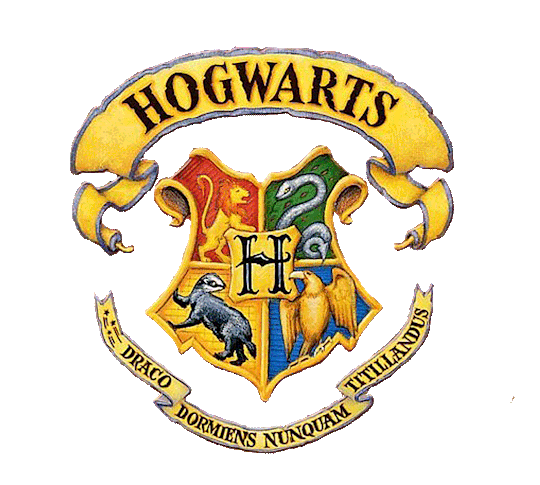
Located in Scotland, Hogwarts School of Witchcraft and Wizardry is the most established magical school in Britain. It was built between the 9th to 10th century (some suspect that it is built in 990 A.D). It is a coeducational boarding school that houses students from aged 11 to 18. There are four houses in Hogwarts, namely Gryffindor, Slytherin, Hufflepuff, and Ravenclaw. They are named after the four founding members of the school, which you will learn more about in the later part of the lesson.
Though they are founding members, none of them were made headmaster or headmistress of the school when it first started. No one truly knows the name of the first headmaster of the school, but there is the existence of a statue of him rumored to be located in a hidden room of the castle.
Despite knowing that the school is located in Scotland, the exact point of location is untraceable and unable to be seen by the Muggle eye. This is because a large variety of charms and spells are used to protect the identity and facade of the school. So, the Muggles are only able to see a large patch of grassland and ruins instead of the compound which consists of the castle, the Black Lake, Quidditch pitch, and various other parts.
Why would we want to keep away from the prying eyes of the Muggles, you might ask? We have to constantly remind ourselves of the era when Hogwarts was founded. It was between the 9th and 10th century. Though we understand from Lesson Two that witchcraft was officially banned between the 12th to 14th century, the fear of magic had already arisen and persecution of magical folk had already taken place. Thus, in order for students to remain safe whilst studying in the compounds, such charms were necessary to protect students from any possible external harm.
Next, let’s look into our school motto. I am not sure about you, but when I was still a student here many years ago, the school motto constantly puzzled me. Literally, “Draco Dormiens Nunquam Titillandus” means “Never Tickle a Sleeping Dragon”. Metaphorically, it is similar to the popular idiom “Let sleeping dogs lie”. The school motto that can be colloquially translated to “Don’t mess with Hogwarts”. Consider Hogwarts to be the dragon that is at rest while students learn and grow peacefully. However, when threatened, the school rises up, meets the occasion and “bites back”.
Architecture of the Castle
There are two parts of the Hogwarts we are going to consider today, namely the castle itself and the Common Rooms.
Castle
Rowena Ravenclaw was the brains behind the architectural design of the castle, while the other three founders did most of the collaborative spellwork and charms that helped to protect and build the castle itself (such as the Anti-Disapparition Jinx).
Hogwarts did not actually start off as a castle but instead a mansion that housed a small number of students. However, it was an aim of the founders that one day this school would house so many students that the building would not be able to handle the number, Thus, over time, they charmed the building to grow along with the number of students. Along with quirky moving staircases, Rowena Ravenclaw designed the castle in a way where the rooms could actually change its location. This allowed the school to possess a mystery factor in the building itself. As the years went on and the school started to grow, this ability for rooms to move about was gradually incorporated to many other parts of the school and came in handy for expansion. Some believed that Rowena Ravenclaw did this so that if the castle was ever to be attacked, the professors and the students would be able to understand the movements and features of the building to hide away from their opponent. However, the opponents would be confused, as they would not know what was going on in the building.
The paintings and pictures were hung up much later, at Salazar Slytherin’s instruction, and they cover almost every inch of the castle walls. While some believe that the moving paintings and photographs acted as a tool for spying on his fellow founders, this was not necessarily the goal. In any case, the portraits have lasted long after the departure and death of Salazar Slytherin and remain here today.
Lastly, due to the magic that occurs throughout the castle, a magical atmosphere is created that disallows any form of technology to be used in the castle grounds. The connection and interference between magic and technology will either cause the technology to break down or not work at all. Thus, electric lights are not used in the school grounds but instead, candles are used as a form of light. Of course, some things have changed and in some specific areas, specific technology can be used.
Common Rooms
Each house has its own set of common rooms, allowing students to stay in dormitory-style lodgings. Each dormitory consists of about four to five beds, as you already well know. However, what you might not know is that each common room has the ability to expand according to the number of students.
The respective common rooms also have the characteristics of its respective house and colour scheme.
2 notes
·
View notes
Text
Mythology| Tuesday. July 10th, 2018| Lesson Sixteen: Intro to the Americas and Inuit
pAmerican Mythology The mythos of various American cultures is quite diverse, due to the large number of tribes and cultural groups that exist in the region. However, there are many overarching themes that can be drawn out and examined. First of all, there is the concept of harmony in nature. In many cases, American peoples would take great pains not to upset the natural harmony of the world, and many of their rituals, myths, and societal practices reflect this belief. This is not an overly foreign concept to us, of course, as it is a common concept in other ancient societies which you have studied, with the Celts as a notable example. Another commonality between ethnic groups in the Americas is their associations with animals, both magical and non-magical. Whether we are speaking of the jaguar of the Aztec, the bison of the Lakota, or the caribou of the Inuit, all groups had particular animals which they revered and with which they were closely associated. This connection, like their reverence for the harmony of nature, was expressed through myths about their societies and well as traditions and rituals based on cultural beliefs. As the year goes on, you will see a number of examples that demonstrate this point.
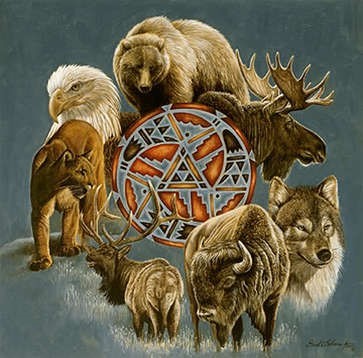
Finally, much like many other ancient societies, magic, myth, and history were highly intertwined. In some cases, so intertwined as to be indistinguishable from the others. That is to say, a historical account of a tribe’s existence may be completely based on their myths. However, recall that just because something is a myth does not automatically mean that it is untrue. Sometimes there is only the basic kernel of truth expressed at the center of the myth, but at other times, myths may recount actual historical events, people, or places. For example, the myth of Bellerophon and the chimera in Greco-Roman culture is full of references to mythological characters, however Bellerophon is the only wizard to have slain a chimera - which is a historical fact. Keep your eyes open for similar characters and beliefs as we explore the mythologies of the Americas this year. To start us off, Professor Morgan will be discussing Inuit mythology for the remainder of our class today.
The Long and the Short of Inuit Mythology
Inuit mythology focuses strongly on animal associations, just as Professor Wessex has outlined for you above, such as those about the polar bear (nanook, in Inuktitut). What makes the Inuit myths quite fascinating and different from other cultures is that their focus is not on creation and the workings of the gods and the universe (although there are myths that outline these aspects of the world), but are more about survival in the treacherous environment in which they find themselves and the cultural values and experiences of the people themselves. Now yes, I am speaking primarily of the cold, barren, arctic region of modern day Canada wherein the Inuit culture has flourished for thousands of years. Many of the myths speak of the hazards of the cold, and the dangers of the animals. Nanook, the Great Bear, is said to be almost human, and the greatest prey of all for a hunter. Of course, a polar bear is also the single most dangerous non-magical creature living around the arctic, and can just as easily kill a human as a hunter could kill it (or rather much more easily since polar bears are enormous, strong, and unafraid of humans.) There are other creatures, however, that may seem mythical in nature to the Muggle population, but bear so many similar traits to known magical creatures that there may be that nugget of truth to them
The Qalupalik
Take for example, the magical cryptid known as Qalupalik. I see those of you who I assume are not studying Care of Magical Creatures looking blankly at me. Let me explain. A magical cryptid is a creature that is magical in nature, but has been seen so few times, that it is assumed to be merely rumor since no specimens have been recorded or captured to this day. Though mostly anecdotal in nature, there is still the possibility that these creatures do exist.
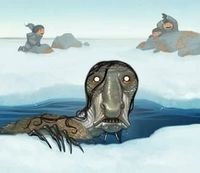
Yes. They are rather horrid looking, or at least this artist thought so. The myth can be summarized as follows: The Qalupalik are creatures that live under the ice. They appear to be somewhat humanoid shaped and female. They wear a cloak with a large pouch called an amautiit (which the Inuit use to carry their children around), and make a humming sound audible to human ears from underneath the ice. As a gruesome twist, they eat children, sort of. The myth states that the Qalupalik will grab children who come to close to the edge of the sea ice - especially those who misbehave and do not listen to their elders (which is what would land them at the edge of the sea ice unattended in the first place). The Qalupalik would snatch the child, shove them into the amautiit, and disappear under the ice. If the first part of this myth is upsetting, the second part is down-right disturbing. The children were not immediately killed, but placed in a sort of stasis. They would remain in that stasis as the Qalupalik slowly drained off their life force -- I hope you remember the concept of a “life force”, that ever-changing thing which sustains the existence of all creatures, from your Defense Against the Dark Arts classes in Third Year. The child would age, most likely at a greatly accelerated rate, and the Qalupalik would absorb their youthfulness, keeping them more or less immortal. As the only victims of the Qalupalik are never seen again, nor are there adults around when the creature strikes, it has been very difficult for magizoologists to verify the presence of this creature.
Sedna
Another very prominent myth in Inuit culture is that of the sea goddess. She goes by many names, including Sedna, Nuliayuk, and Taleelayuk, to name a few. The myth changes based on region and period of time, but we will look at one of the more elaborate versions, for reasons I will expound upon later. The story begins with a young unmarried woman and a cold night, neither of which are uncommon in Inuit life. One evening, a stranger enters the family’s igloo and asks for shelter from the cold. The young man seems odd, and bears a necklace of two sharp canine teeth, but the family offers him hospitality and he spends the night in the family’s bed, where they sleep together for warmth. In the morning, the man has disappeared, and leading away from the house are animal tracks. The daughter of the family is found to be pregnant soon after. Fearing what will come of such a union, the father forces his pregnant daughter to be dragged out on the ice to an island and abandoned. There, in secret and alone, she bears children, half of which appear normal in every way, and the other half who have canine features such as large ears and noses.
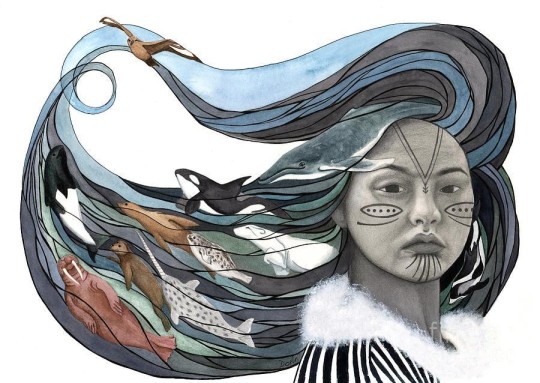
The second part of the myth, after her children are grown, tells of her father’s remorse and his attempt to return her to the village. Unfortunately, the rescue boat becomes trapped by a storm, and the captain, fearing the daughter is either bad luck or dead weight, throws her overboard. She attempts to climb back aboard, but she is cut from the boat many times -- literally -- which results in loss of limbs, to put it gently. These pieces of her are said to change shape and take the form of various sea animals. And while she does not ever make it back to the village, she becomes a powerful goddess of the sea, commanding these creatures of the sea that came from her own body. In some versions, the woman is said to drown. While, in others, it is the father that forces his daughter to marry a dog due to her refusal to wed. Still others describe a great bird or fulmar that tricks her into marrying him and carries her off to an island away from her family. However, I have chosen this version to help illuminate some of the characteristics and facts this myth is thought to represent. Many a magihistorian has examined the versions of this myth and ultimately been unable to ignore the repeated animal transfigurations that feature throughout the tale. There are various competing schools of thought, some saying that this tale displays parallels to semi-modern “half-breed” prejudice, or distrust of those afflicted with lycanthropy, pointing to the stranger who takes the form as both canine and man as an example of a werewolf. However, others argue that this is potentially a heavily fabricated origin story of the first known Animagi in Inuit history and mythology. It is difficult to be sure, of course, but there is certainly more to this gruesome myth than meets the eye.
3 notes
·
View notes
Text
Mythology| Tuesday. July 10th, 2018| Lesson Fifteen: European Mythological Tendencies
Gods and Goddesses
All three of the cultures we discussed have pantheons, and in the case of the Celtic and Norse myths, more than one pantheon. True to all of the pantheons are the relationships of the gods to nature. The god of thunder is Zeus/Jupiter in Greco-Roman mythology and Odin in Norse mythology. Coincidentally both of these gods sit at the head of their respective pantheons. The Celtic god of the sea is Lugh, and the Greco-Roman counterpart is Poseidon/Neptune. In this aspect of their mythologies, all three cultures are demonstrating a connection between the natural world and the gods. Mostly, the myths are there to help explain natural phenomena. A sudden, brutal storm is an angry god demonstrating his displeasure, for example.
Main Character and Creatures
It is when we get to the myths themselves that there are some differences between the cultures. In the first two cultures we studied, the Greco-Romans and Norse, the gods feature prominently in the stories. There may be a mortal thrown in now and again, but the focus of the stories is on the gods. In Greco-Roman mythology, the stories are mostly the antics of the gods themselves and have little effect on how mortals live their lives. These gods are immortal, and their deeds may cause a war or two on occasion, but even the heroes in these stories are either gods themselves, or descendants of gods or other magical creatures In Norse mythology the stories focus on the gods in an almost singular fashion, although mortal heroes do occasionally have run ins with the gods - and magical creatures as well. The difference here is that the Norse gods can die, and the most significant myth is that of the destruction of the world - an event that will have extreme consequences in the mortal world. The odd man out of this group of cultures is Celtic mythology. While a god or two will have a small part to play in a myth - the siring of Cuchulainn, for example - it is the mortals who feature most prominently and in all of their frailty. Morals
If you think about the stories you were told as a child, such as The Warlock’s Hairy Heart, or similar, you also remember the morals that are taught through them. Always tell the truth, don’t steal, work hard, don’t dabble in the Dark Arts. While a bit less obvious, the myths of the Greco-Romans, Celts, and Norse often, if not always, have some sort of moral issue addressed in them. Quite often they discuss the effects of infidelity, such as the Trojan War, the burden of knowledge, such as Odin’s knowledge that Ragnarok was inevitable, and the dangers of tampering with magic, such as the love potion Tristan and Iseult consumed. These myths also show the values that each society held dear such as bravery, duty, and intelligence, although it was quite infrequent that all three were found in a single hero. Odysseus is perhaps the stand-alone example of all three of these values, and his trials lasted for decades. Copyright?
The last aspect of these myths to compare is the similarities between the tales themselves. There are many examples where aspects of myths from two completely different cultures are found to be identical in their telling. The one that stand out the most from our studies this year is the white and black sail confusion. In Greco-Roman mythology, Theseus falls asleep on the ship returning to his father and forgets to change the sails. Believing his son to be dead, Aegeus throws himself off the castle towers into the sea. Similarly in Celtic mythology, Tristan believes the ship bringing Iseult to heal him is flying black sails instead of white, and he dies of heartbreak, believing she has abandoned him.
So what do these similarities mean? Quite simply, that these cultures were never completely isolated from each other and aspects of their myths were absorbed into each other’s stories. This borrowing of aspects of the stories also demonstrates that, while often at war with each other over land, these cultures still held the same values at their core.
2 notes
·
View notes
Text
Transfiguration| Monday. July 9th, 2018| Lesson Four:Critters and Goblets
The Target
Now, as I said this spell does have some restrictions on the target. The most impactful of these restrictions is size. Fera Verto will only work on small to medium sized creatures, generally around the size of a shoebox or smaller. The common targeted creatures for Fera Verto are small house pets or pests, such as rats, mice, birds, and lizards. It’s important to keep in mind that, because the target of this spell may change from one cast to another, you will have to do your own research and analysis of the creature at hand each time you cast the spell to discover what is important about it in terms of the transformation.
Goblet
A goblet, by definition, is a cup or vessel used for drinking that has both a stem and a base. They also go by the name of “chalice” and can be made of glass, metal, and, in some cases, stone.
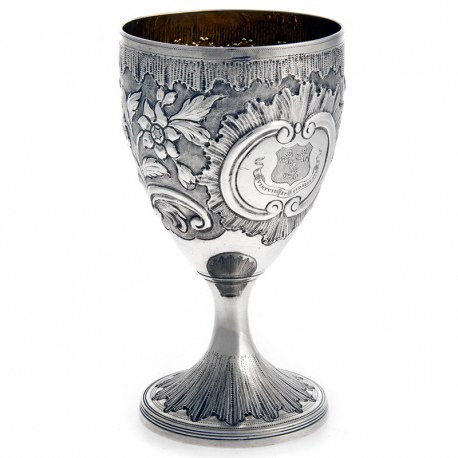
There have been a couple notable goblets throughout lore and wizarding history that I thought it’d be fun to discuss quickly. The first of these is the Holy Grail, a cup said to give happiness, eternal youth, and an infinite supply of food. Though many have gone searching for this cup, none have yet been able to find it and many question its very existence

The second of these notable goblets is the Goblet of Fire. This was the goblet used for the Triwizard Tournament to impartially select its competitors and, while it serves a different purpose than the common goblet, it still qualifies.
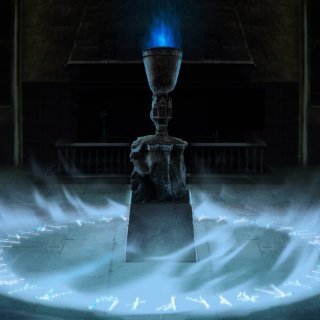
That being said, Fera Verto unfortunately will not be able to provide you with the Goblet of Fire nor the Holy Grail for you can only alter an object physically and molecularly through Transfiguration but not imbue that object with magical energy that it does not inherently possess.
The Transformation
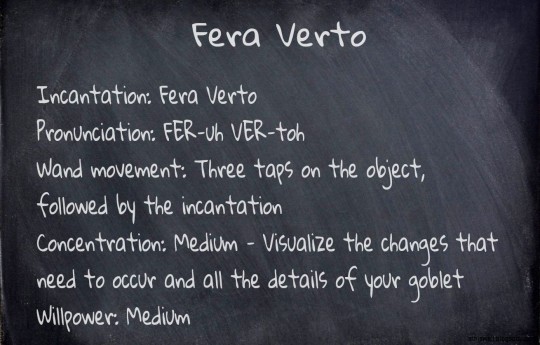
Fera Verto is especially prone to partial transformations as many forget that goblets may be made from an assortment of materials and therefore end up with fuzzy or skin-like cups. In order to minimize your risk of ending up with a partially transformed goblet, remember that your required concentration and willpower will need to be adjusted slightly for the creature at hand. Some creatures may have more or fewer similarities with the goblet and require more or less concentration, while size and complexity ranges among applicable creatures as well, meaning that willpower will be different from casting to casting.
Assessing Willpower
The two big factors affecting how much willpower is needed for a transformation are size and consciousness. Size is a quick judgment call because you can easily assess the comparative size of a target with your eyes. Consciousness, on the other hand, is a little more difficult. Now, I defined consciousness in our second lesson as the state of being awake and aware of one’s surroundings and existence. But for this application, its definition is a little more complex. Different creatures have different levels of “consciousness” depending on their base mental processes. As it pertains to willpower, consciousness is a measure of a target’s mental complexity.
Mental complexity is based on a multitude of things, but the most important are sentience and intelligence. Sentience is the ability for a thing to feel and experience the world subjectively. It is the base level of consciousness and is present in all creatures. Intelligence, then, is the ability for a thing to think, react, and learn. This varies widely from species to species and includes mental processes such as reason and memory.
The final factor that can affect the level of willpower that you need to exert when performing an animate transformation is the level of trust between you and your target creature. The more your target trusts you, the less willpower you will need as their mind will generally be more open to accepting your magic and the change. This is why many people find it easier to cast Fera Verto on their pets rather than on random animals they found.
Origin
The story of this spell revolves around Colin Crestfellow, a wizard who was a little too dependent upon his firewhiskey. Despite his normal intoxicated state, he was actually rather gifted in the art of transfiguration. One day his wife got tired of his lazing around, decided to hide all of the cups in the house in the hopes that it would get him to lay off the firewhiskey. Rather than cutting back, Colin instead attempted to get payback by transfiguring his wife’s beloved pet ferret into a goblet to drink from.
The use for this spell hasn’t changed since it was first invented. It is a convenient spell when you’re in need of the extra cup for unexpected guests, or dinner parties. Due to the flexible nature of the spell, you will almost always be able to find a suitable creature to perform it on simply by walking out into the garden.
0 notes
Text
Defence Against the Dark Arts| Monday. July 9th, 2018| Lesson Eleven: Yeti
The Yeti is a magical creature native to Tibet. Standing up to 15 feet tall, it is a snowy-white furred humanoid that may be related to the troll. The Yeti fears fire allowing for skilled wizards to repel it. However, the Yeti will attack and eat anything that it meets, so no witch or wizard has had the opportunity to study it up close yet.
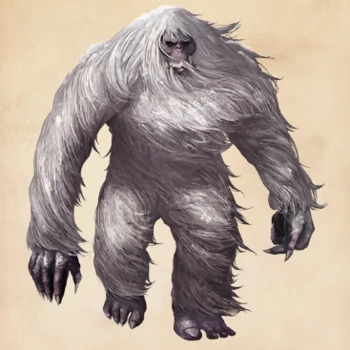
History
Yetis are one of the Wizarding World's worst kept secrets as there had been so many Muggle sightings of the Yeti. Because of this Tibet has one of the worst Wizarding secrecy records, due to its continuing breaches of Clause 73 of the International Statute of Wizarding Secrecy. The International Confederation of Wizards had to place a permanent International Task Force up in the mountains to help control the situation. The Yeti is also known as the Abominable Snowman or Bigfoot (the latter also being an alternate name for the sasquatch). In 1992 Gilderoy Lockhart taught his second year class about the Yeti, probably using his book Year with the Yeti. However, based on his fraudulence, his information is taken from a more accomplished person and his own version is twisted into inaccuracy. In 1998 The Quibbler questioned whether 4 Yeti footprints were sighted or if it was another prank. Xenophilius Lovegood misspelled Yeti as Yetti.
Fun Facts
The yeti is a creature purported to live in the portions of the Himalayas encompassing Nepal and Tibet, generally considered in modern times to be a misidentification of various types of bear native to the region, or a hybrid species of bear. The name "Abominable Snowman" derives from an account of a sighting of the creature in 1921 by a Lieutenant-Colonel Charles Howard-Bury. Bigfoot, on the other hand, describes a similar creature supposedly found in the Pacific Northwest of the United States, believed to have derived from a combination of local folklore, misidentification of local fauna, and various hoaxes.
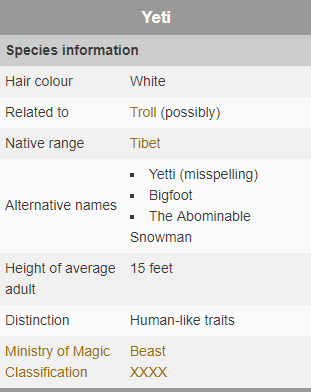
0 notes
Text
Mythology| Thursday. July 6th, 2018| Lesson Fourteen: Heroes and Lovers
Today we have only two stories to tell, however they are quite extensive, and full of magic and passion alike. Our first story is that of Tristan and Iseult (also known as Isolde or Yseult), a pair of lovers in a forbidden relationship that has influenced the telling of the love triangle between King Arthur, Guinevere, and Sir Lancelot as well as Shakespeare’s tragic play, Romeo and Juliet. Picture this: two great lands, divided only by the sea. The great King Mark of Cornwall on one side, and Ireland on the other. A boat sails from Ireland to Cornwall carrying King Mark’s bride-to-be, Iseult. At her side is Tristan, knight and nephew to the king. The hate between them is palpable. Iseult sighs and thinks back to the events that have transpired to bring her here. The Irish knight Morholt’s death at Tristan’s hands. Tristan’s slaying of the dragon tormenting her people. Her healing of Tristan’s wounds with her magic before realising he is an enemy of her people. Her father’s eagerness to agree to King Mark’s proposal to end this enmity. Not to mention the terrible weather which seems to be elongating the journey across the straight, carrying her to her fate. Tristan finds himself also frustrated with the turn of events, and parched after the magical healing that Iseult has performed on his wounds. He stands, and goes searching for any further drink aboard to quench his thirst. After a brief and almost fruitless search, he finds one bottle left amid Iseult’s possessions. He briefly recalls Iseult’s mother giving her the bottle and telling her to share it with the king on their wedding night. Believing the king would not fault him for an indiscretion as slight as this, he opens it and pours himself a drink. He sighs as he thinks of his uncle’s upcoming nuptials. Perhaps he had best make sure that the bride arrives in good health as well, and so he pours the remaining contents of the bottle into a goblet and returns to the table. He offers the goblet to Iseult, who accepts it graciously, if not thankfully. Rather parched herself, Iseult drinks from the goblet, surmising that the king’s need for peace overshadowed any threat on her life. The liquid tasted a bit off; not quite the beverage she was expecting, or perhaps it had fermented a bit. No matter, it would do. Finishing the drink, she felt Tristan’s eyes upon her. Looking up, she quickly realized that his demeanor had changed. Gone was the bemused, reluctant escort. What remained were the eyes of a man very much impassioned. A very handsome, strong, brave man. \ Their tryst over, the lovers realized that they are completely in love with each other, and yet bound at the same time to the parts they are to play in the peace between their kingdoms. Before we go any further in the story, what do you surmise has happened here? If you guessed love potion, you would be completely correct. Iseult’s mother was very much a witch and she had brewed a potion for Iseult that would make her fall in love with her future husband, and he with her in turn. Unfortunately, it was used on the incorrect recipients - with dire consequences.
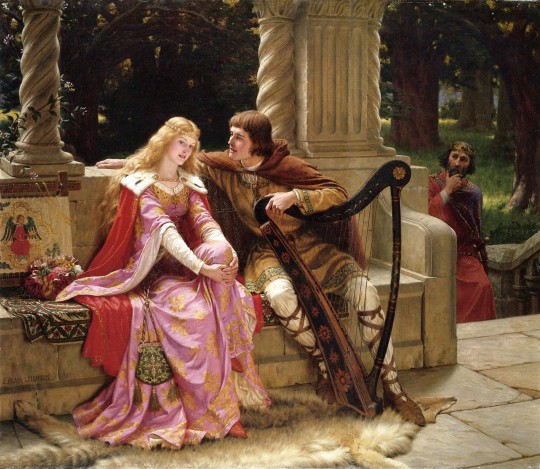
Even though the lovers know that Iseult’s marriage to King Mark is crucial to the peace between their kingdoms, even though Tristan knows the punishment for continuing this relationship with his uncle’s wife, they cannot stay away from each other. The effects of this love potion are so strong that they are physically and mentally unable to stay apart. Some versions of the myth state that the potion wore off after three years, after which the two chose to continue their affair, while others insist that the potion’s effects were unending. Either way, the affair was eventually discovered by King Mark, and Tristan chose to be exiled to the mainland. The bizarreness of this tale does not end there, however. Upon his arrival in the mainland, Tristan chooses a new wife, Iseult of the White Hands. Yes. Another Iseult. The man must have been a glutton for punishment, or perhaps it was the only way he could continue to handle the effect of the potion. It was not a happy marriage, for Iseult of the White Hands was fully aware of Tristan’s love for King Mark’s Iseult of Cornwall. Years later, Tristan is mortally wounded during battle, and only the healing powers of Iseult of Cornwall can heal him. He send a desperate letter to her, begging her for help, which she agrees to immediately. The message to Iseult of Cornwall asked her to fly white sails if she was aboard the ship returning to Tristan, and black if she was not onboard. Alas, Iseult of the White Hands was so bitterly angry at Iseult of Cornwall for stealing her husband’s heart for so long, she told Tristan that the sails were black. Tristan died instantly from a broken heart. Not long afterward, Iseult of Cornwall also perished from the grief of finding her beloved already dead upon her arrival. Tragic, wouldn’t you agree? There are obvious similarities to Greco-Roman myths that we discussed earlier this year, but the most interesting aspect of this story is the cause of the relationship: the love potion. I am certain that you have been warned multiple times by parents, professors, friends, and others to avoid dabbling with love potions. If you learn nothing more from the myth of Tristan and Iseult, for the love of all things, do not take a love potion! Do not believe them to be a simple prank either - the results are more dire, life-changing, and possibly lethal than you may first believe. Cuchulainn
Our second story is in truth more of a saga. The complete telling of Cuchulainn’s myth would take hours, if not days to complete. As your other professors might be a bit peeved if I kept you sequestered for that long, I will do my best to summarize the most salient details for you. The myth can be broken down more or less into four sections: Cuchulainn’s birth, his complete idiocies, his great heroism, and his death. As was mentioned in our previous lesson, Cuchulainn’s coming was foretold by a great wizard of the time. In his prophecy, however, the wizard neglected to mention how odd his birth would be. There are slight variations of the tale, but the core facts remain the same regardless of the version. Dechtire (also known as Deichtine), daughter of Cathbad, the very wizard who predicted Cuchulainn’s birth, finds herself shelter in a peasant’s house during a storm, along with several of the king’s hunters. During the night, the peasant’s wife goes into labour and a son is born. In a strange twist, the house and the peasant’s vanish during the night, leaving only the newborn baby. Deichtine claims the boy as her own and returns to the castle. In a cruel twist of fate, the boy becomes sickly, and dies. Dechtire is beyond distraught at the loss of the child. Somehow, and here is where the versions differ, she finds herself miraculously with child, and soon gives birth to a son, who she names Sétanta. The father is generally agreed upon to be the god Lugh (or Llew), who was also the peasant whose house had disappeared so strangely. It is this second child, Sétanta, who is destined to become the great hero, Cuchulainn. He is fostered by many of the king’s men, including the great poet Amergin, not to be confused with the great wizard Amairgen. During his youth, his incredible strength becomes apparent. When, due to a miscommunication from King Conchobar, the blacksmith Culann’s great hound attacks Sétanta, he easily slays it, much to the grief of the owner. Even though the hound’s death was in self defence, Sétanta feels guilty, and swears to guard the smithy until a new hound can be raised. Henceforth, Sétanta was called Cuchulainn - which translates into “hound of Culann”.
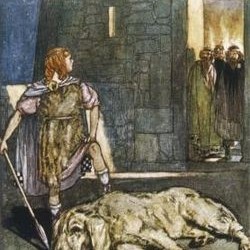
If I could define Cuchulainn’s behaviour in his youth in one word, it would be “hasty”. That penchant for quick actions without much thought behind them characterized much if not all of Cuchulainn’s actions throughout the rest of his life. Many of those actions were acts of bravery, but a great number of them were quite foolish. Take, for example, the manner in which Cuchulainn was married. As a great warrior, he could have any woman he chose, but had his sights set on the lady Emer. Emer was in love with Cuchulainn and had no objection to his pursuit. Her father, Forgall Monach, did not want Cuchulainn for a son-in-law. He demanded that Cuchulainn head to Alba (modern day Scotland) and train with renowned warrior-woman, Scáthach, hoping that Cuchulainn would be killed by the ordeal. Wanting only Emer, he accepted the challenge. Unfortunately for Forgall, Cuchulainn thrived during the training, and also met Ferdiad, another trainee who became his best friend and foster-brother. During one of their greatest battles for Scáthach, Cuchulainn defeated Aife, Scáthach’s greatest nemesis. To keep her life, Aife agreed to Cuchulainn’s oddest demands: stay away from Scáthach, and bear him a son. His training thus completed, Cuchulainn left Alba and the pregnant Aife, and returned to claim Emer. Forgall refused to honour his agreement with Cuchulainn, resulting in the death of several of his men as well as Forgall’s own life as he fell from the battlements during Cuchulainn’s single-handed siege on the castle. Cuchulainn claimed Emer as well as all of Forgall’s fortune, and returned with his bride to Ulster. Eight years later, the son Aife has borne to Cuchulainn journeyed to Ulster to find his father. Sadly, the boy refused to identify himself when he arrived at Ulster, and Cuchulainn decided to kill the unidentified intruder. As the boy lay dying, Cuchulainn saw the ring he had left Aife to give to his son, and realised his grievous error. The boy told Cuchulainn that he would have carried the flag of Ulster all the way to Rome for him - pledging himself to his father’s king - and then died. Cuchulainn is grief stricken that his rashness has now cost him the life of his son. Alas, the needless death of his son does not cure Cuchulainn of his rash behaviour. Having cheated on his wife while trying to win her hand, it will not surprise you to learn that Cuchulainn continued to cheat on a regular basis even after his marriage. Emer, for her part, seemed to tolerate the behaviour, except for an affair with the sea god Manannan mac Lir’s wife Fand. Fand is quite enchanted with Cuchulainn, and he with her. Seeing the love her husband has for the fairy, Emer first tries to kill her rival. When her attempt fails, she concedes defeat, and lets her husband go. Fand, touched by this magnanimous sacrifice, decides to return to her own husband. Manannan decides the entire affair is best forgotten, and waves his cloak between Cuchulainn and Fand, making them forget they had ever met.

The culmination of Cuchulainn’s heroism and, ultimately, the cause of his death centres around a bull and a lover’s quarrel. Yes, that is correct, a bull. The king and queen of Connaught, Ailill and Medb respectively, had an argument one evening about who was richer than the other. They came out equally matched, except Ailill had a great white-headed bull called Finnenbach Ai. Determined to be at least equal to her husband, Medb discovered that another bull, equal or greater than her husband’s could be found in Ulster. Her offers to buy the bull refused, Medb took her forces to Ulster to claim the bull as her own, and a great and terrible war started between the two kingdoms. As the champion of Ulster, Cuchulainn found himself at the head of a long and bloody battle. Through many trials and tragedies Ulster was ultimately victorious with Queen Medb fleeing back to Connaught. Alas, during this war Cuchulainn is forced to kill his best friend Ferdiad as they were fighting for opposite sides. He also loses his life during the final battle, as one of Medb’s warriors throws three enchanted spears at the warrior. The first kills Laeg, Cuchulainn’s charioteer, the second his horse, and the third goes through his belly, spilling his innards.
Determined to see the battle to the end, our dying hero ties himself upright to a boulder, killing any warrior who comes near him. Even in death, his arm raised above his head as he passes, he kills one more of Connaught’s men as his sword drops and cuts off the warrior’s head. What about the bulls, you ask? Sadly, Ulster lost its bull in the final fray - Ailill and Medb ushering it to their home ahead of their retreating army. Ulster does has the last laugh however, if nothing else. Their bull fights the white bull of Ailill when they are introduced, and both perish. The king and queen are now equal in fortune, but both are bereft of a bull. All to end a spat between a husband and wife. What an incredible waste. With great power comes great responsibility. Unfortunately many of those with great power also seem to have been plagued with a rather large dose of stupidity mixed with a superiority complex. As for Cuchulainn, well, it’s not easy being a hero. In fact, it’s downright horrid and rather fatal.
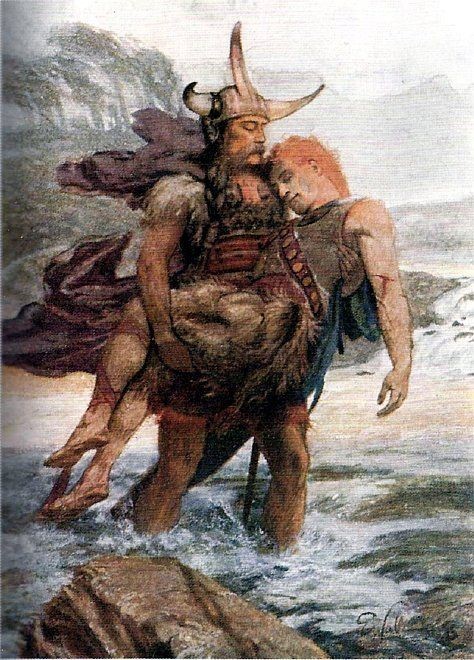
So why have we discussed this myth today? It does indeed have references to magic use: the prophecies of Cathbad, a magical cloak that causes people to forget each other, and, of course, the enchanted spears that end Cuchulainn’s life. More fascinating are the pieces of Cuchulainn’s story that are almost exactly the same as those found in Greco-Roman mythology as well. Cuchulainn acts quite similarly to Heracles in both his strength and battle prowess, as well as his rash behaviour. The death of his son at his own hands is similar to many myths in Europe, but most notably that of Oedipus and the death of his son. Yes, the Celtic myths are depressing. They are also filled with passion and duty and all of the frailties of humankind - an aspect of mythology not mimicked by the other European mythologies we have examined.
2 notes
·
View notes
Text
Mythology| Thursday. July 6th, 2018| Lesson Thirteen: Celtic Pantheon, Otherworlds, Seers, and Enchantments
Pantheons and Great Families
All of the mythologies we have covered in this class have had a very distinct pantheon. Some of the names may have changed or been adapted to fit local history, but they have remained more or less the same. This pattern changes with the Celtic people.
One very important thing to remember when discussing Celtic myths is that the Celtic people migrated significantly during their time, and therefore there are three distinct areas - often with distinct stories and pantheons as well. These areas are Ireland, Wales, and the mainland - now parts of modern-day France. The two most prevalent pantheons are the descendants of Dagda, also known as Daghda (Ireland) and The Children of Don (or Donn - Welsh), which are depicted below.
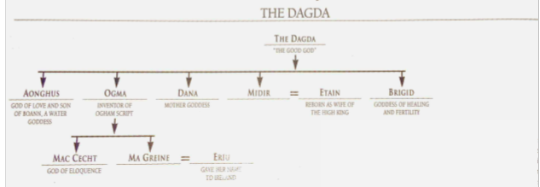
Ultimate Encyclopedia of Mythology
Some of you may be pondering why these charts seem shallow as compared to some of the other civilizations we have covered in this class. The truth is, they are much more complicated. Throughout many stories the genealogy of the gods is discussed, and these stories quite frequently contradict each other. There is so much contradiction, in fact, that scholars simply cannot agree on one interpretation over another. As such, there is not a genealogical chart that I can show you that will work for all of the stories we will discuss. You will simply need to understand each story on its own, disconnected with the others we will encounter.
Another factor that differs from other mythologies I have covered in previous lessons is that Celtic myths focus much more on the heroes than the gods. Certainly, the gods may be involved now and again, but it is the men and women of the great families that make up the vast majority of the myths. The three most notable of these families are those of Ulster, Fionn mac Cumhaill (Finn Maccool), and the Children of Llyr (Lir)
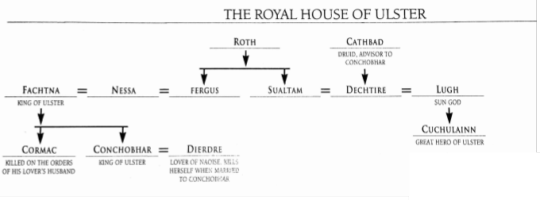
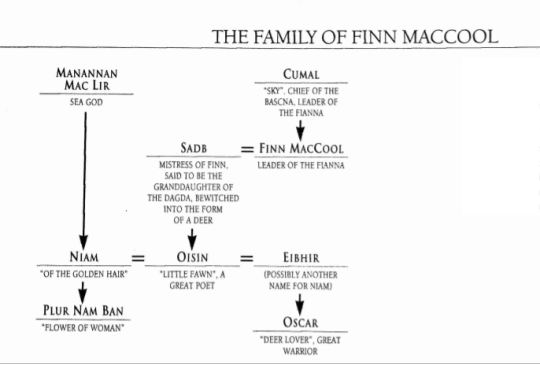
There are numerous other characters and genealogies that can be found when closely looking at Celtic mythology, however the ones above are more than sufficient for our brief foray into the topic.
The Celtic Otherworlds
Featuring prominently in Celtic mythology are references to the Otherworld, or Otherworlds. Similar to Norse mythology where Midgard, Niflheim, and the other worlds existed alongside each other, Celtic mythology also features several other parallel worlds to our own. Some scholars believe that these Otherworlds are simply different areas of a singular parallel world, but most believe that they are all separate, as journeys between Otherworlds do not occur in the myths.
The Otherworlds are the realms of the gods, spirits, fairies, elves, and giants. They are said to be the source of magical creatures, items, and practitioners, however their environments varied greatly. You could find yourself in an utopian paradise, or just as likely in hell. The landscape could be wooded or sterile, warm or cold - one could never tell before crossing over. Many characters in the myths travelled to one of these worlds, whether on purpose or by fateful accident, however, within these Otherworlds, time passed at a different rate. You could find yourself spending an hour in one, only to find that a decade or longer had passed in your own world.
Norse mythology featured a physical bridge connecting worlds, however Celtic mythology speaks more of a veil between worlds, a barrier that was thinner or thicker, depending on magical concentration and use, interference of the gods, and the time of year. It was universally acknowledged by the Celts that the veil between worlds was thinnest at Samhain.
One of the most famous Otherworlds was known as Annwn. This Welsh Otherworld was full of lush gardens, places to rest, and soothing bird songs. It was also home to a magical cauldron guarded by nine maidens. This cauldron was said to heal the sick and restore the dead to life. However, even the most beautiful and appealing Otherworld had its dangers. In this case, Arawn, Lord of Annwn, and his pack of hell hounds flew throughout the realm at night in pursuit of human souls. Best not to be out in magical forests after dark, wouldn’t you say?
Another well known Otherworld, this time of the Irish tradition, is Tír na nÓg, sometimes called Tír na hÓige. It is in this Otherworld where the majority of the Irish gods, called the Tuatha dé Danann, dwelled. The gods chose to live in this Otherworld after the arrival of the humans on their shores as it was the realm of everlasting youth, beauty, health, joy, and abundance. Humans were often lured to Tír na nÓg either by its eternalness or by the beauty of one of the gods.
The most famous story involving a human crossing to Tír na nÓg is that of Oisín and Niamh (or Niam). Oisín was a mortal man, son to Fionn mac Cumhaill, who fell in love with Niamh, who was from the Otherworld. Loving him as well, Niamh begged him to come to Tír na nÓg where they could live together, seemingly forever. Aiding Oisín in their journey was a horse that was capable of travelling over water, and together they crossed the veil.
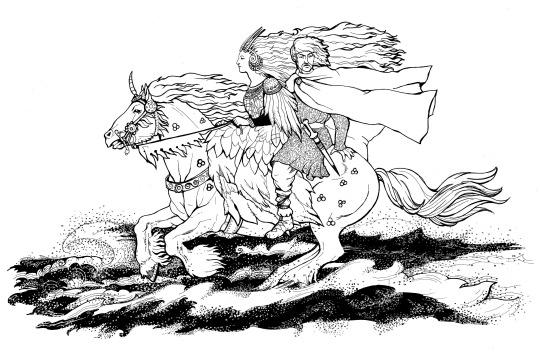
Oisín and Niamh cross the veil
After about three years, Oisín grew terribly homesick and begged Niamh to let him return home to visit. She reluctantly gave him leave, but bade him to stay on the magical horse who would bring him back after his visit. Oisín agreed, and crossed the veil once more.
Upon Oisín’s arrival home, Oisín discovered that 300 years had passed on Earth during his absence. He was so shocked at this realization that he fell off of the magical horse. Alas, once his connection with the magic was broken, his connection to the Earth was renewed and he immediately aged as the missed years caught up to him. He passed away quite quickly.
Seers
Another common feature in Celtic mythology is the practice of divination, specifically by Druidic seers. As mentioned in Year Four of Ancient Studies, Druids kept no records of any kind. Therefore as we examine the myths involving seers, it is important to note that we are uncertain to this day if these myths are fact, fiction, or, in the most likely scenario, a combination of both. Three of the most famous of these seers are Amairgen (Amergin), Taliesin, and Cathbad.
Amairgen
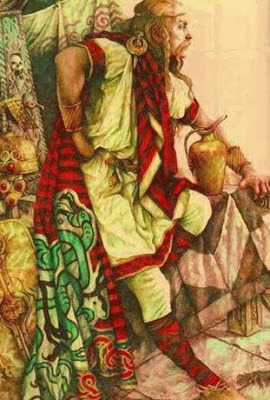
Amairgen, High King of Ireland
Amairgen was a very early Druid - one of the first of the Irish Druids. He was also the first High King of Ireland. He is most famous for a historic and lengthy battle, during which he negotiated - through sword and word and most definitely magic - permission to settle Ireland. During the largest sea battle of this conflict, Amairgen worked an incantation to call a great storm. His divinatory abilities made him aware that the casualties on both sides would be extensive, however he was running out of options. The incantation in the myth is more of a poem, and has been translated as follows by the Muggle Lady Gregory Augusta:
"I am the wind on the sea; I am the wave of the sea; I am the bull of seven battles; I am the eagle on the rock I am a flash from the sun; I am the most beautiful of plants; I am a strong wild boar; I am a salmon in the water; I am a lake in the plain;
I am the word of knowledge; I am the head of the spear in battle; I am the god that puts fire in the head; Who spreads light in the gathering on the hills? Who can tell the ages of the moon? Who can tell the place where the sun rests?
Now I am certain that these words are not really part of the spell. As far as magihistorians can tell, there are no specific incantations in this passage, however if this myth were true, Amairgen would have been using a rune-inscribed staff and the words he said would have been superfluous to the spell - perhaps said even before he actually cast it. Regardless, this is one of the earliest myths to feature a druid.
Taliesin
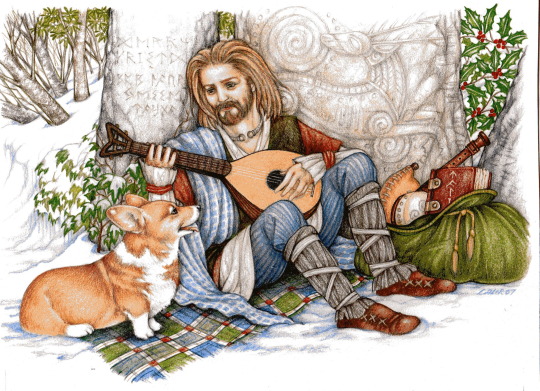
Taliesin the Bard
Perhaps you have heard of our second druidic seer, Taliesin. On occasion you may see Taliesin as another name for Merlin, or as a companion of Merlin and King Arthur, however this is not accurate. They are indeed two different people living in two different times. Taliesin was known to Muggles as the greatest bard. In fact, one of his nicknames was Father of the Bards, for he could spin a great tale. Of course the ability to use charms to enhance those stories went a long way to bolstering his reputation!
It is, though, the lesser known abilities that make Taliesin stand out from the others. It was he who foretold and tried to warn the people about the arrival of the Saxons on their shores. He also warned of the resulting oppression his people would face, as well as his own death. The myths indicate that deep meditation gave him the visions of the future, and that he also journeyed to the Otherworld. It was also thought that he was an animagus who could turn into an eagle.
I’m sure most of you have noticed that Taliesin’s story sounds more historical than mythical. These stories are some of the most difficult for magihistorians to examine and sort into one category or another. I will leave you to decide for yourselves what you wish to believe. Regardless of your choice, you will become part of a debate that has lasted for centuries!
4 notes
·
View notes
Text
Astronomy| Thursday. July 6th, 2018| Lesson Seven: Moons of the Solar System [part2]
Extended Example: Martian Moons, Part Two
Let us briefly talk about the magical effect that Phobos and Deimos have on Mars. Like the Earth’s Moon, both Phobos and Deimos reflect magical energy from the Sun onto the surface of their host planet. Because the moons are tidally locked to Mars, it is easy to predict the amount of magical energy that is reflected from the faces of each of the moons. However, predicting the amount of magic reflected onto Mars by its moons is slightly more complex than computing how much magic the Moon reflects onto the Earth - each of the two moons has phases, and both of the two moons orbit at different periods.
Of the two moons, Phobos - being the larger and closer one to Mars - will have a larger magical impact on Mars than Deimos will. However, there are times when an observer on Mars may experience an occultation. Due to the different orbital periods, Deimos may be occulted by Phobos. When this happens, this will form a powerful syzygy that strengthens magic.
In summary - yes, the moons of Mars have a magical effect on Mars. However, due to the fact that the planet has two moons, the magic effects may be slightly harder to predict.
Shepherd Moons of Saturn
While the moons of Saturn play significant roles in the planetary system of the planet, they also are a vital aspect in maintaining the most well know and striking feature of the planet, the magnificent rings! Of the 62 fascinating moons, I would like to draw your attention to five in particular, known as Shepherd Moons.
Shepherd moons are those which orbit between or around the rings, using their gravitational influence to help shape, or "shepherd" the rings into the perfect orbits that we recognise. These moons prevent the individual rocks and particles which make up the ring system from drifting off into an unorganized mess, and help to keep the rings separated into their individual paths.
Ushering the A ring (the ring closest to the planet) is Atlas! Atlas resides close to the inner edge of the A ring, orbiting between it and the planet itself. It is believed to have a more erratic orbit due to strong influences by some of the larger moons orbiting nearby.
Around the F ring (the furthest ring from the planet) we can see two misshapen moons, Prometheus and Pandora! These two heavily cratered bodies orbit on either side of the F ring, constantly pushing and pulling upon it through gravitational forces, making it the most active ring in the system. Similar to Atlas, they have quite irregular orbits, due largely to their close proximity to the rings (which exert a gravitational pull on them as much as they do on the rings in return) and other nearby, larger moons. Despite wobbling in their orbits, they always stay close to the F ring acting as its guardians.
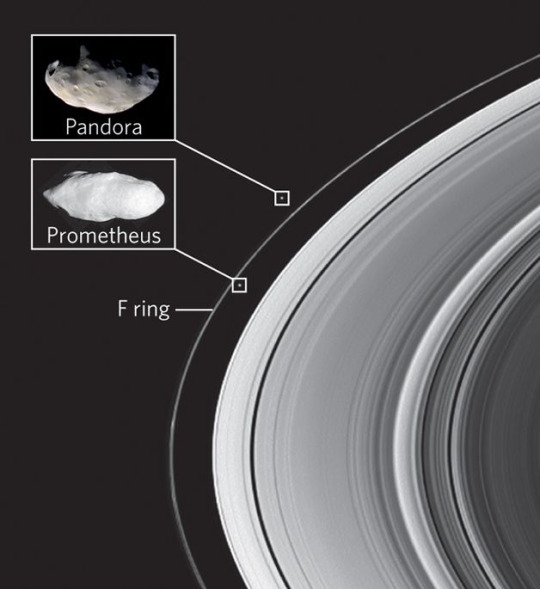
The two remaining shepherd moons act a bit differently. Instead of ensuring rings stay in place and maintain their shape, they cause gaps within the largest ring, the A ring. Pan is responsible for the Encke Gap within the ring, while Daphnis is the cause of the Keeler Gap. These moons were likely once part of the debris comprising the A ring which has been pulled together over time by gravitational forces to form the small moons. Because of their increasing size, further debris was attracted to them during their orbits, leaving their orbital plane devoid of further particles and causing the gaps we are able to observe.When considering the strength and ability of the magic being harnessed from the ring system, it is important that you take the position of these moons into consideration. When using magical forces from the rings, consult a planet chart to determine the current location of these shepherd moons. When two moons are near one another, on opposite sides of a ring (such as Prometheus and Pandora in the previous picture), it can help amplify the magic being projected from that ring. In opposition, if the moons have moved to the far side of the ring or only one moon is present, the gravitational influence on the ring can warp it out of shape and diminish the quality of the magic.
1 note
·
View note